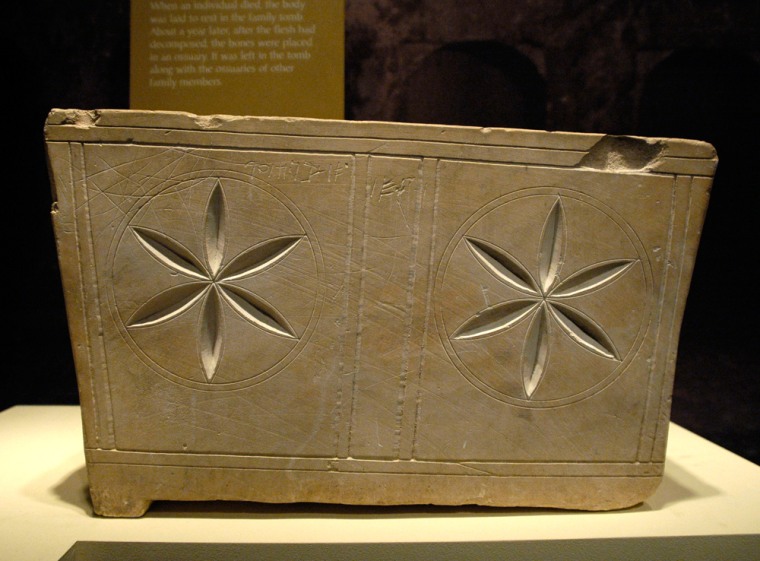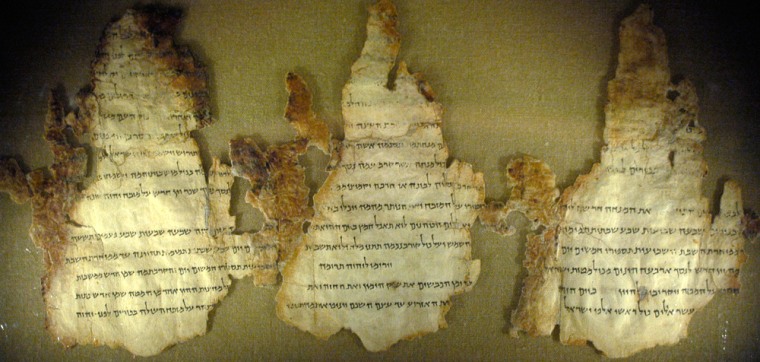Small, oddly shaped fragments of an ancient Hebraic scroll appear almost like tiny flames as they lay enclosed in a glass protective case with lighting that makes the handwritten text stand out.
The pieces are from the Temple Scroll, one of eight Dead Sea scrolls stored at the Shrine of the Book at the Israel Museum in Jerusalem. It's a commentary about ritual and rules at the second Temple, a place where many Jews from about 2,000 years ago would have visited and worshipped. It was a place key to the experiences of Jesus.
The newly restored scroll segments are on display for the first time. They have been added to the Israel Museum's early Christianity exhibit, which has only been on view previously in Jerusalem to mark the new millennium in 2000. The traveling exhibit, which is making its first stop in suburban Cleveland, seeks to document the historical linkage of early Christianity to the Jewish culture of Israel.
The "Cradle of Christianity: Treasures From the Holy Land" opened Saturday and continues until Oct. 22. It's the first major visiting exhibit for the Maltz Museum of Jewish Heritage, which opened in Beachwood, about 30 miles from Cleveland, about six months ago.
"It's very significant that both Passover and Easter occur so soon after opening this exhibition. The community response has been inspiring and embracing," said Carole Zawatsky, the Maltz Museum's executive director.
Milton and Tamar Maltz, the museum's co-founders, arranged about $1 million to bring the exhibit from Israel. Zawatsky said the hope is at least 100,000 people will visit, drawing viewers from Christian communities who might not otherwise come to a museum usually focused on the history and experiences of Jews.
The exhibition will next travel to Florida and The Museum of Art Fort Lauderdale and then to Atlanta and the Michael C. Carlos Museum of Emory University.
"It's important to all of our communities from the standpoint of education and appreciation, and for those engaged in the process of reconciliation where there still might be barriers," said the Rev. Otis Moss, pastor of Olivet Institutional Baptist Church in Cleveland. The Rev. Joseph Hilinski, who represents the Cleveland Catholic Diocese on interfaith issues, said the exhibit would help Christians understand how deeply embedded their roots are in Israel.
The exhibit shows similarities in development and structure of churches and synagogues up to seven centuries after the time of Jesus.

It also includes many archaeological discoveries, property of the Israel Antiquities Authority, some of which include names from the New Testament. A burial ossuary, a boxlike limestone holder for bones, shows the name of the Jewish high priest Caiaphas, and a stone tablet bears an inscription with the name of the Roman governor Pontius Pilate, who sentenced Jesus to death.
Some of the displayed ossuaries from the time of Jesus show the name Yeshua, which, according to David Mevorah of the Israel Museum, can be thought of as the name Jesus, a common name at the time.
Mevorah, curator of Hellenistic, Roman and Byzantine Archaeology, pointed to one of his favorite items: a small collection of coins — one silver, the rest smaller, dark bronze.
"Every Jew had to bring each year a half shekel donation to the Temple," Mevorah said. "You can see half a shekel right here (the shiny, silver coin). But it's not a currency most people would carry in their pockets. So they would bring bronze coins or other currencies to be exchanged at the money changers who were sitting all around the Temple.
"These eleven bronze coins are a commission for half a shekel. Jesus was very critical of that, because this was using holy donation for profit."
One item on display is an ankle bone with a nail through it, a possible remnant from a crucifixion. It was found in a very plain ossuary bearing the Hebrew name Yehohanan son of Hagkol.
Mevorah said there is nothing in the exhibit with any direct link to Jesus.
"But there is still a lot of archaeology going on, and new discoveries are being made all the time," he said.
